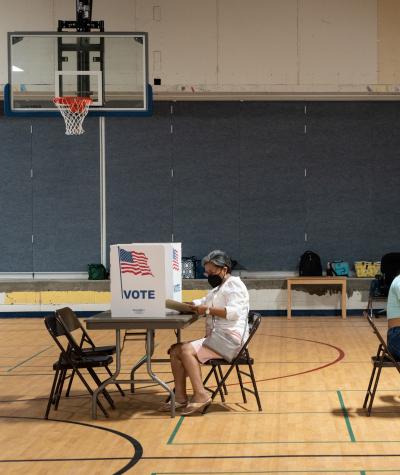Voters deserve to have an equal opportunity to cast their ballots safely and effectively. In-person voting is the most popular method for voting in U.S. elections, and in some states, the only method of voting for the majority of voters. Even amid the COVID-19 pandemic, over half of voters — 54% — voted in person during the 2020 general election.
All voters should be able to complete their ballot at a polling location on Election Day or during the early voting period, but a voter’s ability to easily vote in person can depend on where they live.
Some states don’t provide universal access to mail voting, so those voters must go in person to exercise their freedom to vote. Whether a voter must vote in person or chooses to vote in person, we need to ensure they have equitable access to the ballot box.
Do people have problems voting in person?
Yes, laws that limit the freedom to vote have created barriers that prevent many voters from having equitable access to in person voting. Overall, Black, Hispanic and Native American voters face greater barriers to in-person and early voting than white voters.
In 2013, the U.S. Supreme Court gutted a provision of the Voting Rights Act (VRA) that stopped many discriminatory voting laws from going into effect in the case Shelby County v. Holder. Many discriminatory laws that were previously blocked were changes to early and Election Day in-person voting access by state and local governments.
Since then, racially targeted attacks on the freedom to vote have gotten worse, with states and localities taking advantage of the lack of federal oversight to erect barriers to voting for members of marginalized communities.
Attacks on in-person voting are particularly pernicious because changes to Election Day polling places typically occur at the local level, making those attacks harder to track and challenge.
What problems have marginalized communities faced when trying to vote in person?
One problem voters of color face is when jurisdictions remove, consolidate or relocate polling places in their communities. Black, Hispanic and Native American communities have experienced polling place closures at a higher rate than white voters.
Changes to polling place location can cause confusion when voters show up at the wrong location. Voters usually have to wait in line longer in places where officials have closed or consolidated their polling places. This can also mean fewer voting resources are available to voters, such as voting machines or poll workers.
Polling place closures have been especially prevalent in Southern states with high Black populations. Between 2012 and 2018, Louisiana parish governments closed 126 polling places, Mississippi county governments closed 96 polling places and Alabama county governments closed 72 polling places.
Closing or consolidated polling locations compounds other barriers voters face, especially when a state requires voters to cast their ballot at a specific location.
For example, advocates demonstrated in the U.S. Supreme Court case Brnovich v. Democratic National Committee (DNC) that Black, Hispanic and Native American voters in Arizona were more likely to encounter obstacles to voting in the form of “out-of-precinct” bans, which is when a ballot doesn’t count at all if the voter fails to vote at their designated polling location.
These voters are more likely to experience a change to their polling place and be unable to submit their ballot at their old location or have time to travel to complete their ballot at their new location. They also may have to travel further to the nearest polling location or that journey may take longer because of lower rates of car access.
Laws have similarly targeted voters of color by restricting the alternatives to in-person Election Day voting, like limiting the number of early voting days or restricting access to vote-by-mail, methods of voting that can reduce long lines at polling places on Election Day.
How can we protect voters’ access to in-person voting?
Every American can help protect our neighbors’ access to in-person voting. Issue monitoring, administrative advocacy to local officials and state legislative advocacy can help promote equitable access to in-person and early voting.
Issue monitoring involves advocates examining decision-making about polling place locations and closures to identify problems early on. They must identify the relevant decision-makers in their location and the timelines for those decisions and should be conscious observers of issues going on at the polls on Election Day.
Administrative advocacy involves community members demanding better in-person voting access from their local government, which makes most of the decisions regarding Election Day polling places and early voting.
State legislative advocacy involves supporting legislation that requires notice to voters of changes to polling locations, establishes certain minimum standards of access and requires local governments to consider certain criteria for polling places, allowing state legislatures to establish parameters for in-person voting access that local governments must follow.
Advocates can also press for state-level Voting Rights Acts, like the John R. Lewis Voting Rights Advancement Act of New York and Voting Rights Act of Virginia, which establish preclearance for polling place changes so that local governments cannot make changes that have discriminatory results.
The right to vote is a basic American freedom, and we must safeguard that right to give every American an opportunity to have their voices heard on the issues that matter to them.
